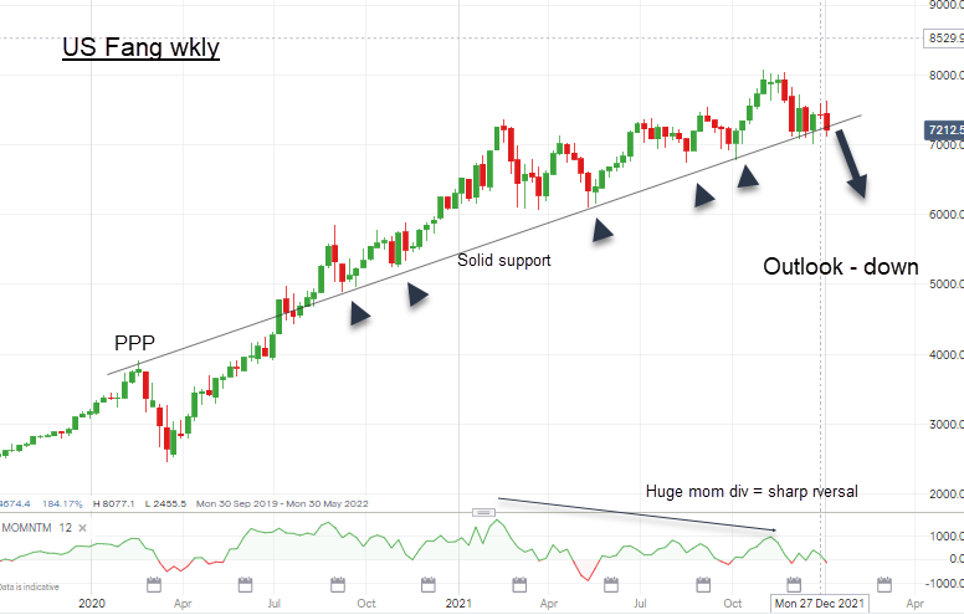Chart of the week: time to take profits on these trades?
10th January 2022 13:39
by John Burford from interactive investor
With central bank policymakers caught between a rock and a hard place, our technical analyst looks at the big tech names like Apple and Netflix, and at stocks more broadly.

Are the FAANGs losing their teeth?
It is no secret that the major US indexes, especially the S&P and Nasdaq, have been led by extreme investor focus on the big-name tech titans with mega-caps. The most prominent of them is the group known as FAANGs (or FANG+). They comprise Facebook/Meta (NASDAQ:FB), Apple (NASDAQ:AAPL), Amazon (NASDAQ:AMZN), Netflix (NASDAQ:NFLX)Alphabet (NASDAQ:GOOGL)/Google and Microsoft (NASDAQ:MSFT) (the '+'). And all of them have advanced sharply off the March 2020 corona crash lows.
That is, until now.
- Want to buy and sell international shares? It’s easy to do. Here’s how
- Best 39 growth stocks for 2022
In recent days, the shares have fallen off their all-time highs and many have broken below key support levels. Late last year, I covered the advancing Apple and suggested it was at, or very near, a major high and on the brink of a significant correction (latest trade at $172). And now, the first trading days of the new year have provided even more clues that the others in the FAANG gang are joining Apple in rolling over.
And since the FAANG gang led on the way up, it will surely lead on the way down.

Past performance is not a guide to future performance.
This FAANG chart goes back to the March corona-crash lows and, collectively, it has surged from 2,480 to the recent high at 8,050 – an astonishing gain of 265% in less than two years. No wonder these became known as the 'Never Sell' growth stocks. But a warning; no tree grows to the sky and eventually it topples over!
Of course, investors were enthused by the earnings potential caused by the pandemic lockdowns, where working on laptops from home remotely surged. And Netflix was boosted by those furloughed in house arrest who watched films on the couch (and/or opened Robinhood share trading accounts to become instant 'experts' at day trading).
- Friends & Family: ii customers can give up to 5 people a free subscription to ii, for just £5 a month extra. Learn more
Looking to diversify your portfolio? ii’s Super 60 recommended funds is full of great ideas
But interestingly, while Zoom Video Communications (NASDAQ:ZM) – the universal means of keeping in touch with work colleagues – were initially boosted in the first lockdown, the shares actually topped in October 2020, just around the time many 'value' shares started turning up off major lows (including banks). It is now trading 70% off its all-time high and making new lows.
Back to the chart, and the market is on the verge of breaking hard below the major uptrend support line. Note the Prior Pivot Point (PPP) that usually anchors a lengthy major line separating support and resistance. And note the large momentum divergence at the 4 November high, a sign of flagging buying power into the high.
As for Netflix, the shares have now broken below key support and are trading 24% off their 15 November record high. Ouch!

Past performance is not a guide to future performance.
Netflix has now broken below my major lower wedge line but is into chart support where we could see a bounce. That may be an ideal opportunity to adjust portfolios. But if the support gives way over the next few days, it should be in a hard down phase.
One data point caught my eye on Thursday: Bloomberg reported that of the 100 shares in the tech-heavy Nasdaq index, almost 40% of them have plunged by at least 50% from their one-year highs. That is not a bullish sign – and it appears to be leading the general markets lower.
The last index holdout – the Dow Jones – made its high last Wednesday just after release of the December Federal Reserve minutes from where it reacted badly.
- Three shares expected to climb
- Watch our new year share tips here and subscribe to the ii YouTube channel for free
In fact, the Fed is caught between a rock and a hard place. Does it continue with stimulus to prevent a stock crash, or does it tighten to fight rapidly rising consumer inflation?
One of the keys in this jigsaw puzzle is the energy markets. If crude oil and natural gas maintain their uptrends (as seems likely), my money is on rising price inflation and sagging stocks this year.
Again, I believe it prudent to take at least some profits, especially in the well-known tech names.
John Burford is a freelance contributor and not a direct employee of interactive investor.
These articles are provided for information purposes only. Occasionally, an opinion about whether to buy or sell a specific investment may be provided by third parties. The content is not intended to be a personal recommendation to buy or sell any financial instrument or product, or to adopt any investment strategy as it is not provided based on an assessment of your investing knowledge and experience, your financial situation or your investment objectives. The value of your investments, and the income derived from them, may go down as well as up. You may not get back all the money that you invest. The investments referred to in this article may not be suitable for all investors, and if in doubt, an investor should seek advice from a qualified investment adviser.
Full performance can be found on the company or index summary page on the interactive investor website. Simply click on the company's or index name highlighted in the article.
Disclosure
We use a combination of fundamental and technical analysis in forming our view as to the valuation and prospects of an investment. Where relevant we have set out those particular matters we think are important in the above article, but further detail can be found here.
Please note that our article on this investment should not be considered to be a regular publication.
Details of all recommendations issued by ii during the previous 12-month period can be found here.
ii adheres to a strict code of conduct. Contributors may hold shares or have other interests in companies included in these portfolios, which could create a conflict of interests. Contributors intending to write about any financial instruments in which they have an interest are required to disclose such interest to ii and in the article itself. ii will at all times consider whether such interest impairs the objectivity of the recommendation.
In addition, individuals involved in the production of investment articles are subject to a personal account dealing restriction, which prevents them from placing a transaction in the specified instrument(s) for a period before and for five working days after such publication. This is to avoid personal interests conflicting with the interests of the recipients of those investment articles.